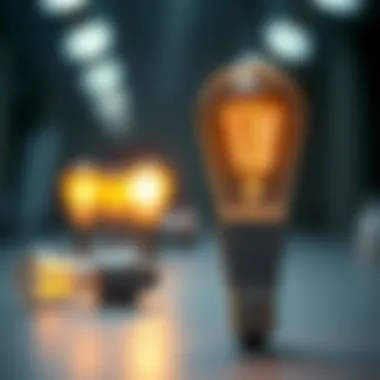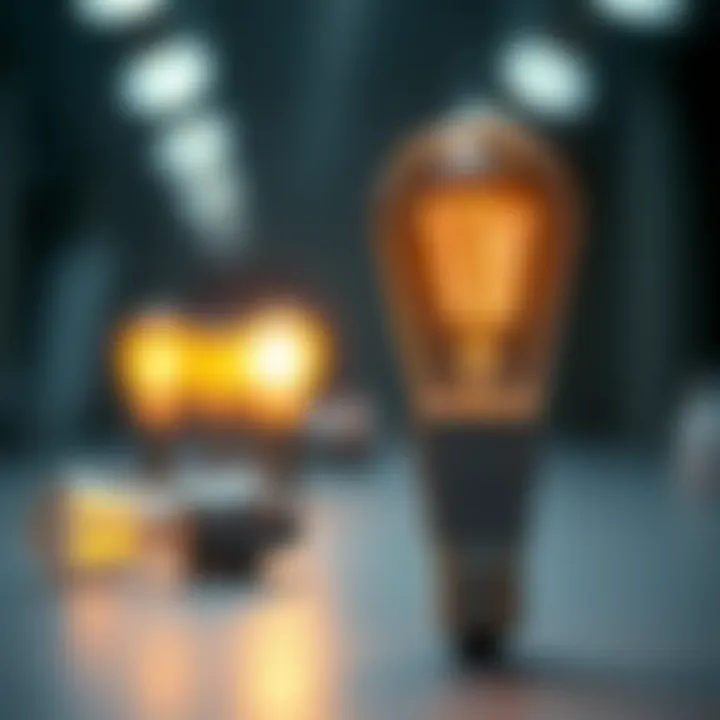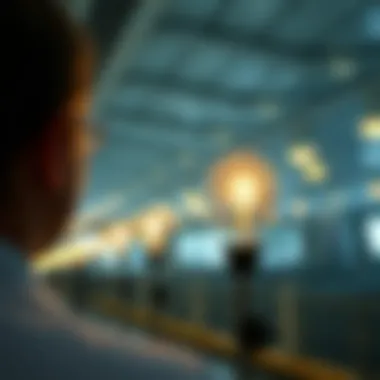The Importance of Low Power Light in Today’s World


Intro
Light-emitting diodes (LEDs) and other low-power lighting solutions have transformed the way we think about illumination and energy consumption. These technologies not only lessen the burden on electrical grids but also contribute to reduced greenhouse gas emissions. In addition, newfound applications in research laboratories and innovative technologies promise to further optimize energy usage while providing superior functionality.
As we delve deeper, we will dissect the various research methodologies that highlight this significant transition. We will explore how scientists and navigators of technology utilize a plethora of tools to probe into the advantages offered by low power lighting systems, drawing a line between tradition and innovation. The discussion will also reference comparative studies that embody the evolution of this area, yielding a comprehensive understanding of its impact in our contemporary lives.
Defining Low Power Light
Low power light refers to lighting technologies that operate with reduced energy consumption while still providing adequate illumination. This shift towards low power systems marks a significant development in the way we illuminate our environments, whether in homes, workplaces, or industrial settings. The importance of defining low power light stems from its multifaceted benefits that extend well beyond mere brightness.
One of the key notes is energy efficiency. With an ever-increasing emphasis on sustainability, low power light sources such as LED and compact fluorescent lamps are gaining popularity. Unlike traditional incandescent bulbs that waste energy as heat, low power lights convert a much larger portion of their energy into visible light. This means that far less electricity is used for the same output, resulting in lower utility bills for consumers.
Additionally, low power lights boast a longer lifespan compared to their older counterparts. For instance, while incandescent bulbs typically burn out within a thousand hours, LED lights can last for tens of thousands of hours. This durability not only reduces waste but also lessens the frequency of replacements, offering economic advantages over time.
Not to mention, the adoption of low power lighting solutions can lead to a reduction in the carbon footprint associated with lighting. Shifting from high-power lighting solutions to lower power options can contribute to the broader climate goals set forth in national and international agendas.
The considerations around low power light also encompass aspects of health and safety. Because low power light sources tend to produce less heat and are designed to minimize glare and eye strain, they can improve comfort and productivity in work and learning environments. In today’s fast-paced world, sustainable and safe lighting is no longer just a luxury but a necessity.
Thus, defining low power light and understanding its broader implications serve as crucial stepping stones toward optimizing its benefits across varying applications.
Principles of Low Power Light
At its core, low power light is built upon essential principles that dictate how it operates. These principles focus on the efficiency of light production, enabling significant energy savings while addressing user needs for effective illumination.
- Photonic Emission: Low power light sources achieve illumination through photonic emission, where energy transitions within materials produce visible light without excessive heating of the source. This contrasts with traditional methods where much of the energy is lost as heat.
- Material Efficiency: Modern technology leverages unique materials such as semiconductors in LEDs, allowing for the manipulation of energy states to produce light in a more energy-efficient manner.
- Smart Integration: Many low power systems incorporate smart technology that optimizes usage based on environmental factors. For example, lights that adjust brightness based on the presence of natural sunlight further enhance energy savings.
These principles are not mere technical specifications but the foundation upon which modern lighting is evolving. By understanding these concepts, users can better appreciate the advantages that come with adopting low power light solutions.
Mechanisms of Light Production
The mechanisms by which low power light is produced are intriguing, revealing layers of complexity behind what may seem like simple illumination. Take the widely adopted LED technology for instance:
- Electroluminescence: In LEDs, electroluminescence is the process whereby a semiconductor emits light when an electric current passes through it. This efficient conversion of electricity to light underpins the high efficiency of these devices.
- Fluorescence: Compact fluorescent lamps operate through a different mechanism. In these tubes, electricity excites mercury vapor, producing ultraviolet light that is then converted to visible light by a fluorescent coating.
- Laser Diodes: Low power lasers utilize stimulated emission to generate coherent light; a process that also stands out for its ability to focus light more precisely than traditional sources.
As these mechanisms become more refined, they contribute not only to energy efficiency but also to performance qualities like color accuracy and brightness uniformity. Understanding these production mechanisms is essential for both practical applications and ongoing innovations in the field of low power light technology. By appreciating the intricacies of how these lights are created, we can more effectively harness their capabilities across various domains.
Technological Landscape of Low Power Light
The technological landscape of low power light is an evolving entity that plays an integral role in how we harness energy and interact with our environments. As the demand for energy-efficient solutions spikes, understanding this landscape helps us grasp the full weight of low power light's influence on our daily lives and global sustainability goals. It showcases advancements and innovations, aids in cost-effective applications, and emphasizes eco-friendliness—a trifecta that resonates with both consumers and industries.
Types of Low Power Light Sources
LED Technology
Light Emitting Diodes, commonly known as LED technology, have revolutionized the lighting industry. At the heart of LEDs is their unmatched energy efficiency, which allows them to produce significantly more light per watt compared to traditional incandescent bulbs. One of the standout characteristics of LEDs is their durability; they can last for tens of thousands of hours, making them a cost-effective choice over more extended periods.
Moreover, their compact size supports innovative designs, which can be a game-changer in various applications, including residential designs and commercial displays. LED technology also has a lower heat emission compared to other types, which is an essential factor in reducing air conditioning costs during warmer months. On the downside, initial investment costs could be higher than traditional bulbs, yet their long-term savings typically outstrip early expenditures.
CFLs (Compact Fluorescent Lamps)


Compact Fluorescent Lamps, or CFLs, bring another dimension to the low power landscape. Their energy-saving capability is noteworthy; CFLs can use about 70% less electricity than conventional bulbs. This essential characteristic makes them a popular choice for eco-conscious consumers looking for immediate savings on their electricity bills.
CFLs emit light through a process similar to traditional fluorescent bulbs but in a compact form that fits standard light fixtures. While their unique feature is a longer lifespan than incandescent bulbs, they do contain a small amount of mercury, which requires careful disposal, highlighting a complex environmental impact. In contrast to LEDs, CFLs can take a bit longer to warm up and reach full brightness, which might not suit all applications, especially those requiring instant illumination.
Low Power Lasers
Low power lasers are another vital component in the low power light spectrum, particularly in specialized applications such as eye surgery and various scientific endeavors. Their precision allows users to target areas with incredible accuracy, minimizing damage to surrounding tissues. This leads to less recovery time and higher success rates in medical fields.
The distinct feature of low power lasers lies in their ability to focus on tiny points without requiring large amounts of energy, making them efficient and effective. As they are becoming more prevalent in both consumer and industrial applications, the continuous innovation in this area raises questions about potential long-term benefits and risks associated with laser exposure. Some people raise concerns about eye safety, requiring regulations and safety precautions as this technology becomes more mainstream.
Comparative Advantages
Energy Efficiency
Energy efficiency remains a cornerstone of low power light technologies. With rising energy costs and growing environmental concerns, low power light sources are designed to consume less energy while providing the same, if not better, lighting experience. By understanding and implementing such innovative technologies, households and industries can significantly reduce their carbon footprints.
The sheer eco-friendliness of low power light sources like LEDs and CFLs plays a crucial role in energy-efficient design. However, it's important to note that while the savings on utility bills can be substantial, the production processes of these technologies can also have environmental ramifications that should be carefully considered.
Lifespan and Durability
The lifespan and durability of low power light sources are significant factors that contribute to their overall efficiency. For instance, LEDs can last over 25,000 hours while CFLs typically last around 10,000 hours. This longevity not only reduces the frequency of replacements but also subsequently lowers waste generation over time.
In practical terms, durability translates into reduced maintenance costs in commercial settings, where lighting needs to be reliable and efficient. One downside is that low power light sources may sometimes require specific handling standards during installation or disposal due to their compositions, particularly CFLs, which can deter some users from fully adopting them.
Environmental Impact
Addressing the environmental impact of lighting technologies is crucial in today's context. The significant reduction in energy consumption from low power lighting helps in decreasing greenhouse gas emissions. It aligns with global efforts to combat climate change and promotes a shift toward sustainable practices.
Nevertheless, it's vital to approach the environmental impact pragmatically. Factors such as resource extraction for materials, manufacturing processes, and disposal methods all play a part in the net environmental benefits of low power light sources. For instance, the presence of mercury in CFLs poses challenges in waste management, which can detract from their perceived benefits. Therefore, a holistic view is necessary to appreciate both the advantages and pitfalls.
Low Power Light in Daily Life
The prevalence of low power light in our daily environments reflects a significant shift towards sustainability and efficiency. These lights are not merely functional; they embody a broader commitment to reducing energy consumption and lessening environmental impact. From the cozy lamps in our homes to the innovative lighting solutions in businesses, low power light serves as an underpinning of modern society, designed to enhance our quality of life while mitigating our carbon footprints.
Applications in Residential Settings
Lighting Design
When it comes to lighting design, low power light stands out as a key player in creating functional and aesthetic spaces within homes. It merges practicality with artistry. One key characteristic of low power light in this context is its ability to provide bright illumination without straining household energy budgets. With emphasis on functionality and comfort, designers are drawn to these options. Using LED strips, for instance, homeowners can mold atmospheres in different rooms, making spaces feel inviting and warm.
The unique feature of low power LED lights is their versatility. They can be dimmed or programmed to change colors, catering to varying moods and activities. This personalization encourages more conscious energy use, greatly benefiting residences. However, there’s a catch; the initial investment for quality fixtures can be higher than traditional options. Despite this, the long-term savings on energy bills and lifespan of the lights make it a wise choice.
Smart Lighting Solutions
Smart lighting solutions represent another fascinating avenue where low power light shines brilliantly. These systems incorporate technology that allows for remote control, automation, and integration with home ecosystems. The ability to program lights to fit specific schedules or to respond to environmental changes – like dimming when it’s bright outside – is a hallmark of these innovative products.
A significant advantage of smart lighting is energy efficiency. Sensors can detect when rooms are occupied and adjust the lighting accordingly, preventing wasteful energy usage. However, the reliance on technology can also introduce complexities; not every household may feel comfortable navigating such systems. These solutions are undoubtedly a popular choice but they come with the need for tech-savviness, which can be a barrier for some users.
Commercial Utilization


Retail and Display Lighting
In commercial settings, low power light plays a pivotal role in the way products are presented and perceived. Retail and display lighting strategies utilize these energy-efficient solutions effectively to draw attention to merchandise. For instance, spotlighting certain items with low power LEDs creates dynamic visual interest without piling up energy expenses. Merchants quickly realize that these systems can enhance sales while being kinder to the environment.
Retail spaces benefit from low power lighting as it provides a good balance between ambiance and visibility. It’s not just about brightness; it’s also how light interacts with colors and shapes of products. Still, while these solutions are increasingly favored for their low energy consumption, they must be maintained and calibrated correctly to avoid issues like glare, which can detract from customer experience.
Office Environments
In office environments, incorporating low power light reaps both energy savings and enhances worker productivity. The right lighting can significantly influence mood and efficiency among employees. Natural light mimicking bulbs that produce softer light tones help maintain alertness throughout the day. Furthermore, low energy bulbs contribute to cost cuts, which is a common incentivizing factor for companies.
Yet, the balance must be struck; overly bright fluorescent lights can lead to discomfort or fatigue. Hence, the emphasis on adapting light to individual needs is gaining attention. While the integration of these lighting choices elevates a company’s commitment to sustainability, careful planning is essential to avoid adverse effects.
"With thoughtful application, low power lighting not only conserves energy but elevates the way we perceive our daily environments."
Scientific Applications of Low Power Light
Exploring how low power light contributes to scientific applications plays a vital role in our understanding of both fundamental and applied sciences. The advancements in this area not only enhance research capabilities but also provide solutions that have far-reaching implications in various fields, such as medicine and technology.
Low Power Light in Research
Spectroscopy Techniques
Spectroscopy techniques utilize low power light to analyze material compositions and chemical structures. Using low power light makes these techniques gentler, reducing the risk of damaging samples, which is particularly important when dealing with biological materials. One key characteristic of spectroscopy is its non-invasive nature. This feature is especially beneficial in areas like medical diagnostics and environmental monitoring.
Unique Features: Spectroscopic methods like Optical Coherence Tomography (OCT) leverage low power light to create high-resolution images of samples, such as tissue layers in the eye, without physical contact. The advantages of these techniques lie in their accuracy and the ability to monitor changes over time without altering the subject, although the techniques may sometimes face limitations in terms of depth penetration.
Microscopy Innovations
Microscopy innovations also heavily rely on low power light technologies, allowing scientists to view specimens at an extraordinary level of detail. Techniques such as Fluorescence Microscopy employ low power light sources to excite fluorescent dyes applied to samples. This enables researchers to track cellular processes and observe interactions in real-time. A significant advantage of this method is the capacity for live cell imaging, which unveils dynamic biological processes without the need for harsh chemicals.
However, despite these advantages, one may find certain drawbacks. For instance, the resolution may not be as high as required for specific applications, making some advanced imaging techniques necessary that could involve compromising on the low-power aspect.
Medical Applications
Phototherapy
In the realm of medicine, phototherapy stands out as a remarkable application of low power light. This technique is primarily used for treating skin conditions like psoriasis and acne. The specific aspect of phototherapy is its ability to deliver light at wavelengths that can penetrate the skin, promoting healing processes or reducing inflammation. Its key characteristic is that it’s an effective alternative to conventional treatments, often associated with fewer side effects.
Unique Feature: Unlike traditional methods that require strong medications, phototherapy offers a targeted approach, minimizing systemic exposure. However, while phototherapy has its advantages, it may require multiple sessions over time, which can be a consideration for patients based on time commitment and financial factors.
Endoscopic Procedures
Low power light has transformed endoscopic procedures, enabling doctors to examine the interior of a patient’s body with minimal intrusion. The characteristic of illumination in these procedures is crucial; the low intensity ensures that patients experience less discomfort while allowing for detailed visuals of tissues and organs.
The unique feature of endoscopy using low power light is its ability to provide high-definition images while reducing heat generation, making it safer for internal examinations. Though highly beneficial, the technology relies on precision engineering, and sometimes the challenge lies in ensuring that the light source remains unobtrusive while maintaining visibility.
Energy Conservation and Sustainability
Energy conservation and sustainability stand as cornerstone ideas in the ongoing discourse about low power light technologies. These elements ensure that our light sourcing decisions do not just illuminate our lives, but also safeguard the future of the planet. With mounting environmental concerns, adopting low power light solutions provides a tangible way to address these issues.


Impact on Energy Consumption
Low power light sources, such as LEDs and compact fluorescent lamps, are revolutionizing the way we consume energy. Traditional incandescent bulbs guzzle electricity like a sponge, while modern alternatives are more akin to sipping from a water fountain. To illustrate, a 60-watt incandescent bulb can be replaced effectively by a 9-watt LED, translating to significant energy savings.
- Reduced Demand: Switching to low power alternatives lessens overall electricity demand on the grid, which is particularly crucial during peak usage hours. This can lead to reduced infrastructure strain and, in some cases, decreased need for new power plants.
- Cost Savings: For households and businesses, this shift can result in noticeable reductions in electricity bills. A simple switch could see annual savings of up to 80% on lighting costs for some users.
- Operational Longevity: Moreover, LEDs last far longer than their older counterparts—often up to 25 times longer. This longevity not only means fewer replacements but also less waste in landfills and reduced manufacturing footprints.
In essence, the ripple effect of low power lighting extends well beyond the immediate switch in bulbs; it reverberates through the entire ecosystem of energy production and consumption.
Contribution to Climate Goals
The link between low power light solutions and climate objectives cannot be overstated. With the urgency of climate change becoming increasingly apparent, the transition towards sustainable lighting is a crucial step in the broader context of environmental stewardship.
- Reduction of Greenhouse Gases: By lowering energy consumption, we inherently decrease the amount of fossil fuels needed for electricity production. This reduction directly correlates with lowering greenhouse gas emissions, making significant strides towards meeting international climate agreements like the Paris Accord.
- Support for Renewable Energy: Efficient lighting is a pivotal player in the larger scheme of integrating renewable energy sources, such as solar and wind. Charging systems that utilize solar panels to power efficient LED lights during the day further underscores how these technologies support sustainable energy solutions.
- Global Impact: Countries around the globe are recognizing the significance of such technologies. For instance, initiatives by the U.S. Department of Energy aim to boost the adoption of LED technology, underscoring how government policies can influence broader environmental goals.
"Adopting low power lighting technologies is not merely a personal choice; it's a collective movement toward a sustainable future. Every watt saved is a step closer to preserving our planet."
While the technical aspects of energy conservation can sometimes read like a dry report, the real-life implications weave a vital narrative. Low power light technologies serve not only as a practical solution for improving energy efficiency but also as a commitment to pushing forward sustainability initiatives that have a lasting effect. By shedding light—chosen carefully, of course—we illuminate the path towards a more sustainable world.
Future Innovations in Low Power Light
The future of low power light is promising, choosing an essential spot in the ongoing pursuit of energy efficiency and sustainable advancements. Utilizing innovative technologies can help bridge existing gaps in energy consumption and environmental responsibilities while enhancing functionality across various sectors. By exploring these innovations, we can grasp their implications on everyday life, from basic residential use to sophisticated industrial applications.
Emerging Technologies
Organic Light Emitting Diodes (OLEDs)
When talking about OLEDs, it’s hard to ignore their growing popularity and how they are reshaping the landscape of low power light technologies. A key characteristic of OLEDs is their ability to produce vibrant colors while consuming significantly less energy than traditional lighting. This feature makes them not just beneficial but increasingly sought after in applications from interior designs to display screens.
One unique aspect of OLEDs is their flexibility. This means they can be integrated into surfaces where rigid lighting units wouldn’t fit. Additionally, OLEDs are thin, lightweight, and their warm glow is easier on the eyes, making them a comfortable choice for prolonged exposure. Though they do have certain disadvantages, like a shorter lifespan compared to LEDs, their growing utility in products holds much promise for the future.
Quantum Dot Technologies
Quantum Dot Technologies are the new kids on the block, and they are significantly changing how we think about light emission. These tiny semiconductor particles, typically just a few nanometers in size, are known for their stellar ability to emit precise colors based on their size often leading to highly efficient and lively displays. This level of customization is a standout feature that appeals to manufacturers and consumers alike.
One of the strong points for Quantum Dots is their potential to improve energy efficiency while providing superior color accuracy. However, it’s worth noting that production costs can be a hurdle; thus, scaling them for wider adoption in everyday applications remains a point to consider. Their incorporation into displays may soon offer a taste of high-performance lighting.
Potential Research Areas
Energy Harvesting
Energy Harvesting is more than just a trend; it’s a crucial way to tap into renewable power sources, making it incredibly relevant in today’s quest for energy efficiencies. This technology meticulously captures energy from various external sources like sunlight, heat, or even movement, converting it into usable power. It often uses low power light sources to generate electricity in an eco-friendly manner, aiming to decrease reliance on conventional energy grids.
The standout characteristic of energy harvesting lies in its sustainability. The potential to harvest energy in various settings hints at a future where our everyday environments can contribute to power generation. With continuously evolving methods, energy harvesting could align perfectly with low power lighting technologies, offering an unusual yet fascinating solution to energy challenges.
Smart Integration and Control
Smart Integration and Control is the brain behind modern lighting systems where technology meets intuitive user experiences. It enables users to control lighting conditions with a flick of a switch—literally or through their smartphone. This feature promotes energy saving as lights can be scheduled to turn off when they're not needed, leading to less power consumption.
A defining feature of smart systems is their adaptability. Users can tailor lighting according to time of day or activities, creating a personalized space while efficiently managing energy use. However, some drawbacks may include installation complexity and potential cybersecurity risks, but as these hurdles are addressed, smart lighting will likely evolve into a mainstream choice for energy-conscious consumers.
In summary, the ongoing innovations in low power light technologies, such as OLEDs and Quantum Dots, along with forward-thinking research in areas like energy harvesting and smart control systems, showcase the transformative potential of these advancements in modern applications. This combination of improved energy efficiency, ergonomic design, and environmental responsibility will play an integral role in shaping the future of light.
For more insights into lighting advancements, visit Wikipedia or check out related discussions on Reddit.
Understanding the nuances and prospective benefits of these developments will arm us for embracing low power light in practical applications effectively.



